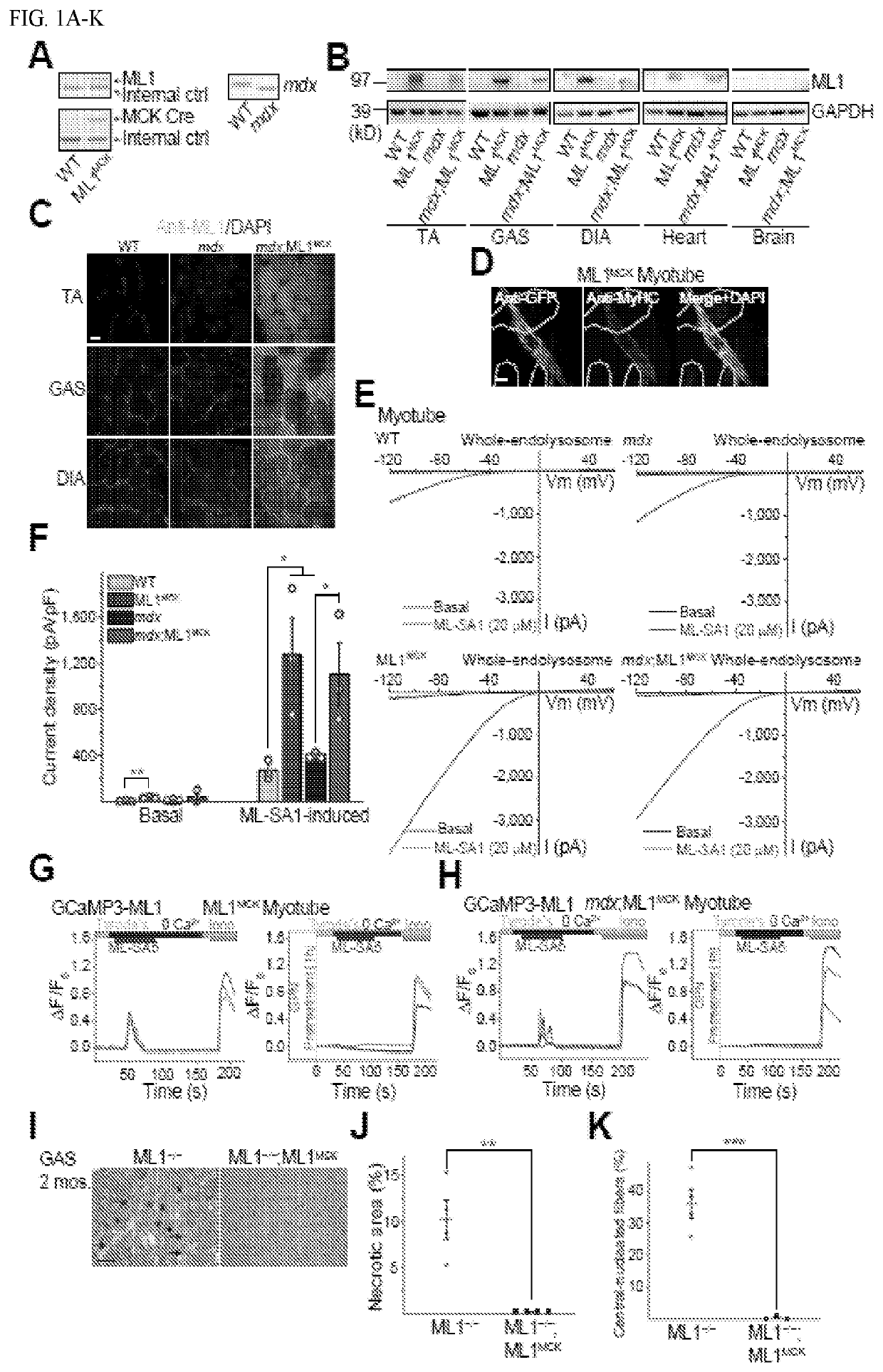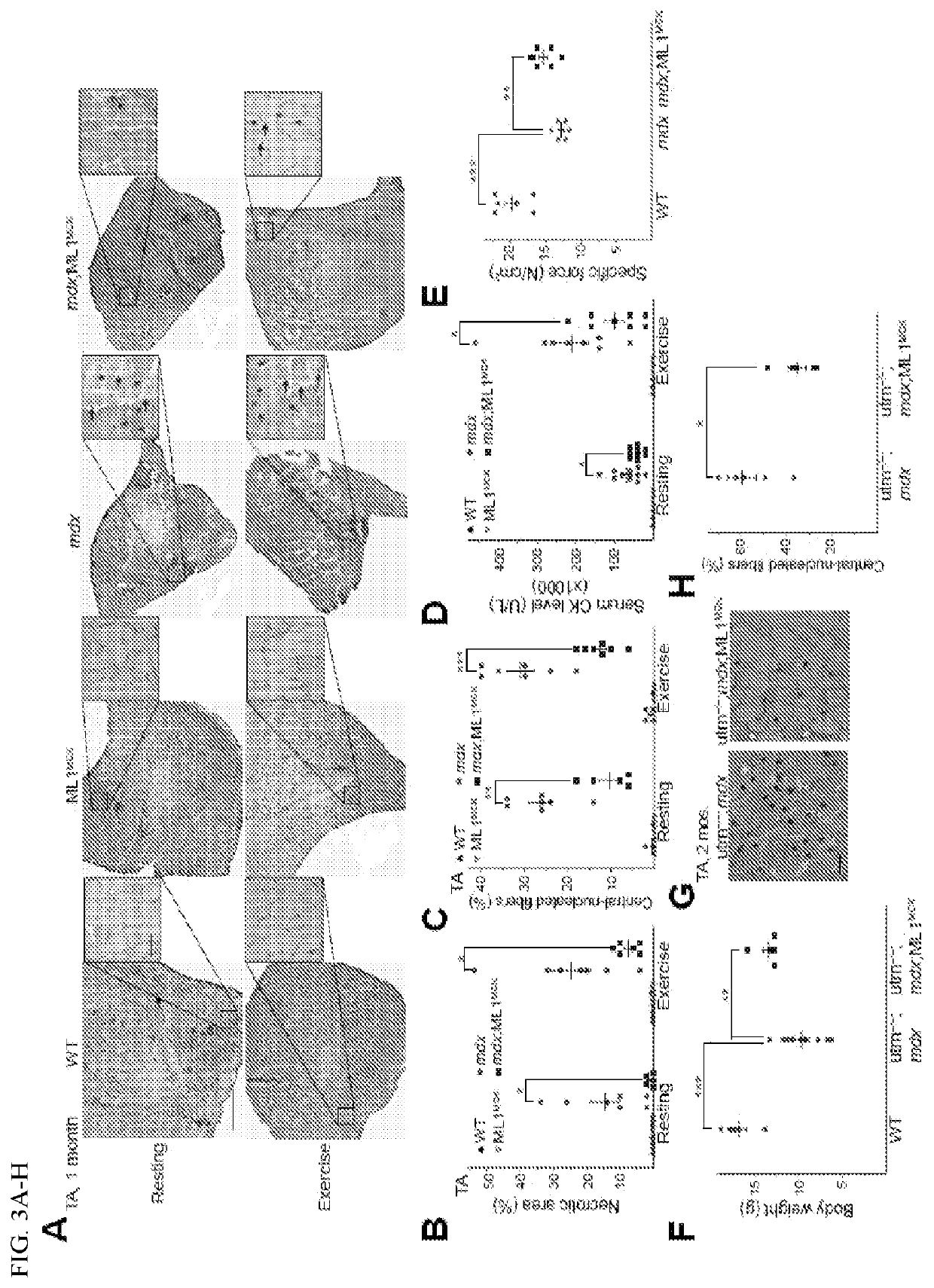Small molecule agonists of mucolipin 1 and uses thereof
a small molecule and agonist technology, applied in the field of small molecule agonists of mucolipin 1 and its use, can solve the problems of no treatment for dmd, muscle damage susceptible to contraction-induced damage,
- Summary
- Abstract
- Description
- Claims
- Application Information
AI Technical Summary
Benefits of technology
Problems solved by technology
Method used
Image
Examples
example 1
4-methyl-N-(2-(piperidin-1-yl)phenyl)benzenesulfonamide
[0120]
A solution of 2-(piperidin-1-yl)aniline (0.176 g, 1 mmol) in pyridine (2 ml) was treated with 4-methylbenzene-1-sulfonyl chloride (0.191 g, 1.000 mmol). The solution was microwaved at 115° C. for 1 hr. To the solution was added toluene (2 ml). The solution was concentrated. To the residue was added MeOH (1 ml). The crude product was purified by reversed-phase chromatography (4-100% CH3CN over 15 min) to give desired product (0.155 g, 50% yield). (LCMS, ESI pos.) Calculated for C18H22N2O2S: 331.1 (M+H), Measured: 331.2. 1H NMR (400 MHz, DMSO-d6) δ 8.57 (s, 1H), 7.68-7.61 (m, 2H), 7.35-7.23 (m, 3H), 7.17-6.98 (m, 3H), 2.46-2.38 (m, 4H), 2.31 (s, 3H), 1.57 (p, J=5.4 Hz, 4H), 1.44 (q, J=6.1 Hz, 2H).
example 2
3-methyl-N-(2-(piperidin-1-yl)phenyl)benzenesulfonamide
[0121]
A solution of 2-(piperidin-1-yl)aniline (0.176 g, 1 mmol) in pyridine (2 ml) was treated with 3-methylbenzene-1-sulfonyl chloride (0.191 g, 1.000 mmol). The solution was microwaved at 115° C. for 1 hr. To the solution was added toluene (2 ml). The solution was concentrated. To the residue was added MeOH (1 ml). The crude product was purified by reversed-phase chromatography (4-100% CH3CN over 15 min) to give desired product (0.155 g, 50% yield). (LCMS, ESI pos.) Calculated for C18H22N2O2S: 331.1 (M+H), Measured: 331.1. 1H NMR (400 MHz, DMSO-d6) δ 8.67 (s, 1H), 7.66 (tt, J=1.7, 0.8 Hz, 1H), 7.60-7.54 (m, 1H), 7.52-7.30 (m, 3H), 7.24-7.14 (m, 1H), 7.10 (dd, J=6.0, 3.5 Hz, 2H), 2.52-2.42 (m, 3H), 1.63 (p, J=5.5 Hz, 4H), 1.51 (q, J=6.2 Hz, 2H).
example 3
2-methyl-N-(2-(piperidin-1-yl)phenyl)benzenesulfonamide
[0122]
A solution of 2-(piperidin-1-yl)aniline (0.176 g, 1 mmol) in pyridine (Volume: 2 ml) was treated with 2-methylbenzene-1-sulfonyl chloride (0.191 g, 1.000 mmol). The solution was microwaved at 115° C. for 1 hr. To the solution was added toluene (2 ml). The solution was concentrated. To the residue was added MeOH (1 ml). The solution was filtered. The solid was dried in vacuo to give desired product (0.040 g, 12% yield). (LCMS, ESI pos.) Calculated for C18H22N2O2S: 331.1 (M+H), Measured: 331.1. 1H NMR (400 MHz, DMSO-d6) δ 8.72 (s, 1H), 7.88 (dd, J=7.9, 1.4 Hz, 1H), 7.55 (td, J=7.5, 1.4 Hz, 1H), 7.45-7.33 (m, 2H), 7.30-7.24 (m, 1H), 7.23-7.18 (m, 1H), 7.08-7.03 (m, 2H), 2.62 (d, J=7.3 Hz, 8H), 1.65 (p, J=5.5 Hz, 5H), 1.53 (q, J=6.5 Hz, 2H).
PUM
| Property | Measurement | Unit |
|---|---|---|
| Composition | aaaaa | aaaaa |
Abstract
Description
Claims
Application Information
 Login to View More
Login to View More - R&D
- Intellectual Property
- Life Sciences
- Materials
- Tech Scout
- Unparalleled Data Quality
- Higher Quality Content
- 60% Fewer Hallucinations
Browse by: Latest US Patents, China's latest patents, Technical Efficacy Thesaurus, Application Domain, Technology Topic, Popular Technical Reports.
© 2025 PatSnap. All rights reserved.Legal|Privacy policy|Modern Slavery Act Transparency Statement|Sitemap|About US| Contact US: help@patsnap.com



